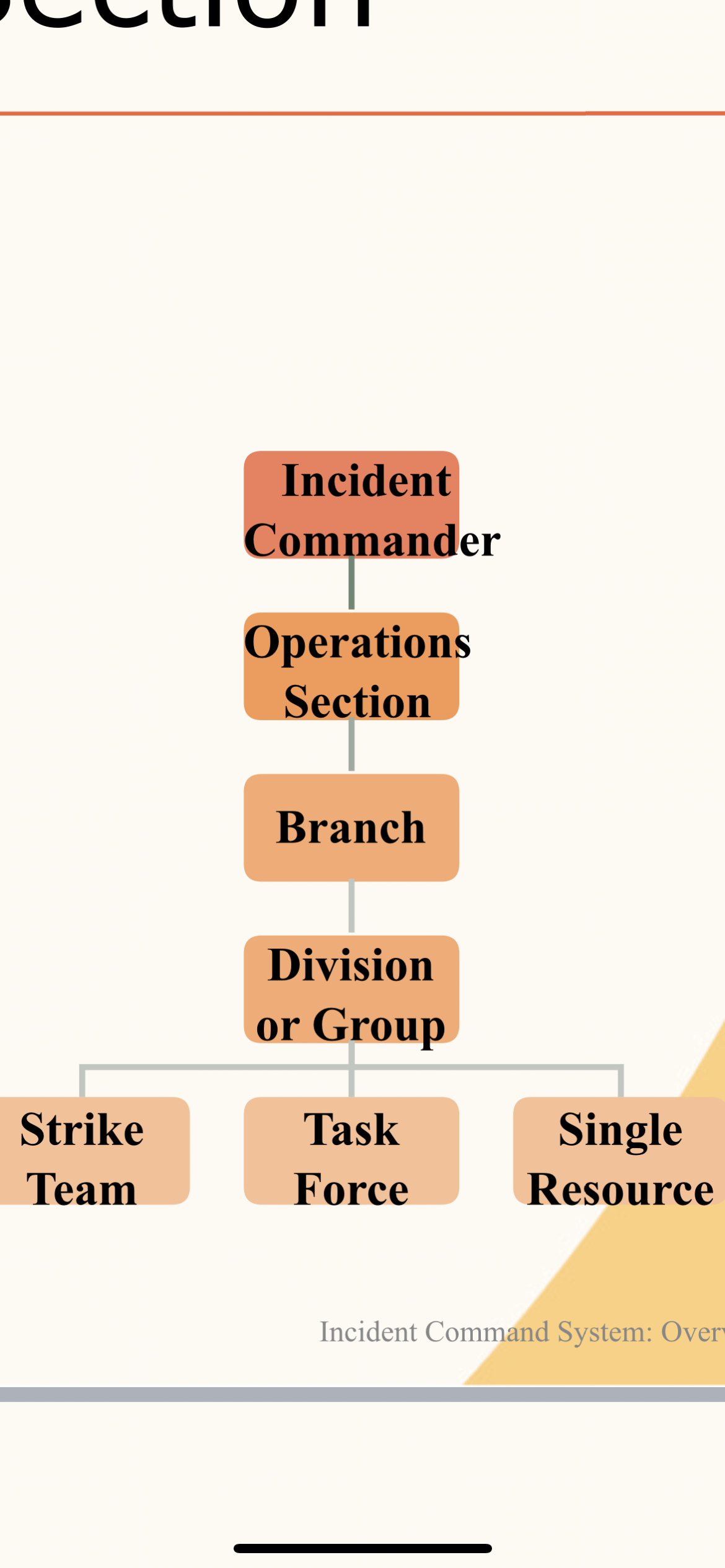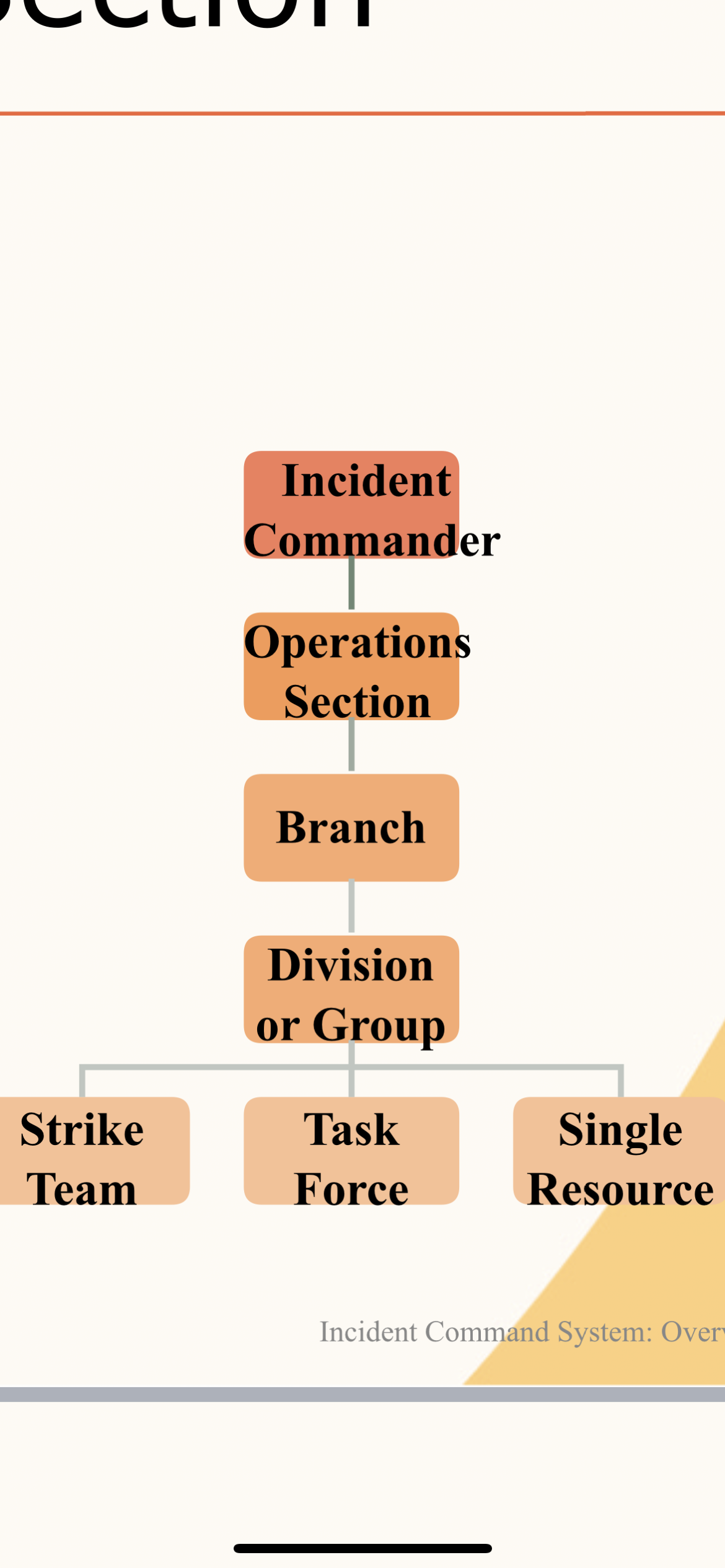INCIDENT COMMAND SYSTEM
1/34
There's no tags or description
Looks like no tags are added yet.
Name | Mastery | Learn | Test | Matching | Spaced |
|---|
No study sessions yet.
35 Terms
INCIDENT COMMAND SYSTEM:
On-scene incident management
–Standard terminology
–Modular, flexible and adaptable
●Adjusts to incident size and complexity
INCIDENT COMMAND SYSTEM: Multiple agency cooperation
●Efficient and effective management
●Multiple sites or jurisdictions
ICS Structure
TOP DOWN STRUCTURE
Five management functions- ILOPF
Incident Command
Logistics
Operations
Planning
Finance and Administration
INCIDENT COMMANDER
–Overall responsibility for incident
●Sets incident objectives
●Determines strategies
●Establishes priorities
–Only position that is always staffed
●Responsible until delegation
COMMAND STAFF: SLP
Safety Officer
Liaison Officer
Public Information Officer
Safety Officer
Monitors safety conditions, practices and procedures
Liaison Officer
–Primary contact for supporting agencies
Public information officer
provides info to stakeholders
GENERAL STAFF: OPLF
Operations
Logistics
Planning
Finance and Administration

Operations Section
●Perform operations to meet incident goals
●Develop tactical assignments and organization
●Direct all tactical resources

Strike Team
@ 1 agency only
Task Force
@ multiple agencies
PLANNING SECTION
●Collect, evaluate and disseminate information pertaining to incident
●Maintain status of resources
●Prepare and document Incident Action Plan
PLANNING SECTION: RDSDT
Resources Unit
Documentation Unit
Situation Unit
Demobilization Unit
Technical Specialists
LOGISTICS SECTION
● Provide support, resources and all other services needed to meet incident objectives
PMFS:
– Personnel
– Materials
– Facilities
– Services
LOGISTICS SECTION: SERVICE BRANCH-CMF
Communication Unit
Medical Unit
Food Unit
LOGISTICS SECTION: SUPPORT BRANCH- SFG
Supply Unit
Facilities Unit
Ground Support Unit
FINANCE/ ADMINISTRATIVE SECTION
● Monitor cost associated with incident
● Provide accounting, procurement, time recording and cost analyses
FINANCE/ADMIN SECTION UNITS-TPCC
Time Unit
Procurement Unit
Compensation Unit
Cost Unit
IAP: incident action plan
● Plan of incident goals
– Required for each incident
– Provides direction
– Preferably written
– Most basic plan outline
▪ What needs to be done?
▪ Who will do it?
▪ How to communicate?
▪ Injured personnel procedures
POSITION AND TITLES
Incident Command - Incident Commander
Command Staff - Officer
General Staff Sections - Chief
Branch - Director
Division or Group (Operations) - Supervisor
Unit (Other Sections) - Leader
Strike Team/Task Force - Leader
SPAN OF CONTROL
Individuals or resources one can supervise
– Vital to effective incident management
RATIO
IDEAL: 1:5
SHRINK RESPONSE: 1:3
EXPAND RESPONSE: 1:7
Unified Command
● Incidents involving multiple agencies
– More than agency or political jurisdiction
● Goals of UC - DFE
– Develop incident objectives
– Facilitate information flow
– Eliminate redundancy
Area Command
● Oversees multiple Incident Command Posts
– Multiple incident sites
– Large, complex incidents
ICS Facilities: I S B C
● Incident Command Post
– Primary command functions
● Staging Area - S
– Resources await assignment
– Possibly multiple sites
● Base - B
– Logistics and administration
● Camp - C
– Food, water sleeping and sanitary areas
SBC
S in circle
B in circle
C in circle
Incident Command Post
Box
Diagonal, line starts from right to left
Upper color it blue
On the incident Scene
● Incident command established
● Command post identified
● Call up ICS staff as needed
● Information to responders/stakeholders ● Incident Response Plan
– Utilize local plans
● Assessments & documentation ● Evaluation
NATIONALLY SIGNIFICANT
eg foot and mouth disease
. All Command and Ceneral staff activated
• 500-1000 Operations personnel per day
• Multiple incident command
• Unified Command Structure required
REGIONALLY SIGNIFICANT
eg exotic Newcastle disease
Small incident
millal response to larger incident
controlled within 24 hours
LARGE EXTENDED RESPONSE
eg Screwworm Myiasis Detection
Larger Incident
Some or all of CS Command and
General start positions activated
• Incident - multiple operational periods (multiple days/shifts)
SMALL OR INITIAL RESPONSE
eg rabbit hemorrhagic disease
• Most or all Command and General Staff activated
Multiple operational periods
Many functional units
Written Action Plan required each day shift
ISOLATED RESPONSE
2-6 ICS personnel
Usually contained
FADD dispatched
Samples taken
Sent to diagnostic lab